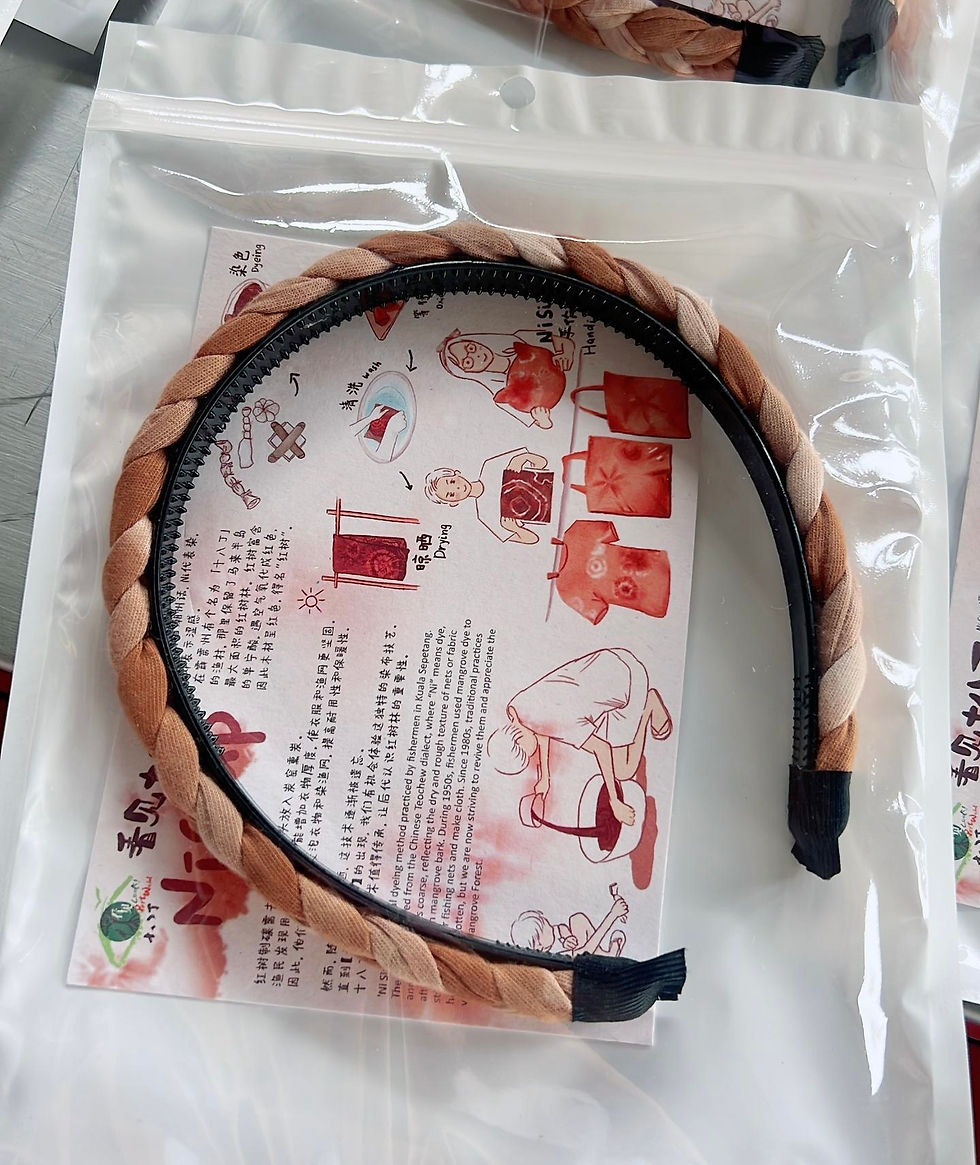故事缘起
NiSiap来自潮州话, Ni是染; 而Siap则是涩感的涩。
在霹雳州有个名为「十八丁」的渔村,那里保留了马来半岛最大面积的红树林。红树林富含单宁酸, 遇空气容易氧化而转为红色, 故被泛称为「红树林」。早期的渔网由布绳或麻绳编织而成,因为渔网长期浸泡在海水,容易损坏及破裂。后来, 聪明的渔民发现红树皮汁可增加布绳的厚度, 所以他们开始使用红树皮浸泡水衣水裤及染渔网, 以增加耐用性和保暖性。随着时代的发展,如今的尼龙渔网已把这项技术失传。社区组织——看见十八丁重新把老祖宗的传统智慧找回来,并引领社区妈妈也下定透过Ni Siap染涩技艺传承和手创,以让后代了解红树林的重要性。
What is Ni Siap?
'Ni Siap' called natural dyeing method by fishermen in Kuala Sepetang. “Ni” means dye, and “Siap” means coarse, from the dry and rough texture of the nets or fabric after dyeing with mangrove bath. Mangroves are rich in tannins, which are easily oxidized and turn red when exposed to air. During the 1950s. fishermen used mangrove dye to strengthen their fishing nets and also made cloth to enhance durability and warmth. Since the 1980s, traditional living has been forgotten, we are trying to bring this back to live and also appreciate the value of Mangrove Forest.
为什么是染涩?
Why Ni Siap?
十八丁渔村已发展成为一个“社区是教室,大地是课堂”的社区,将户外教育融入日常生活,并提供亲身体验自然的机会。 因此,在倡导红树林保护和促进木炭窑行业可持续发展的同时,我们也在开发本地品牌Ni Siap和大自然。
Kuala Sepetang has evolved into a place where "The Community is the classroom, and Nature is the school." integrating outdoor education into daily life and offering firsthand experiences with nature.
Therefore, in advocating for mangrove preservation and fostering sustainability within the charcoal kiln industry, alongside the development of ancillary products like the local brand Ni Siap and natural

“社区是教室,大地是课堂。”
"The community is the classroom, and Nature is the school."
十八丁妇女发展计划
Local Women Empowerment Project
看见十八丁透过社会企业模式,传授地方妇女有关红树林的染涩技术,不仅提供地方妇女就业机会,也顺道保留染涩的传统技艺,同时兼顾了经济和环境。
十八丁妇女发展计划目标如下:
1.运用红树皮自然染涩技艺,打造永续时尚及绿色经济。
2.为当地社区和公众认识红树林的价值。
3.提升地方女性权益,提供她们的创业平台

Look Port Weld Kuala Sepetang has used the social enterprise model to teach local women the NiSiap techniques, it not only provides employment opportunities for local women, but also preserves the traditional NiSiap skills while taking into account both the economy and the environment.
Our initiative is to impart traditional natural dyeing techniques to local women community development aims:
1.To creates regenerative traditional handicraft natural mangrove dyeing leading to a more sustainable fashion and textile economy.
2. Help local communities and the public understand the value of mangroves.
3. Promote the rights of local women and provide them with a platform for entrepreneurship
如何染涩?
How to Ni Siap?
人們進一步發現了利用紅樹皮汁液「澀水」(siap4-zui4)來重複保養衣物和漁網的古老民間智慧,當地人稱這種技藝為「染澀」(潮州話:ni1-siap4)。製作出來的特殊衣物稱為「水衣水褲」(潮州話:zui1-sna1/zui1-koh3)。在1940至1960年代物資相對貧乏之際,十八丁漁村家家戶戶以手工製作這些衣物,供漁民及在沼澤地砍伐紅樹的勞動者使用,以應對特殊潮濕的工作環境。


Over time, villagers discovered an ancient practice of using mangrove bark extract, known as "siap-zui" or “hard water”, to preserve and strengthen fabrics and fishing nets. The locals call this technique, called "ni-siap” in Teochew, or “dyeing with hard water”. The resulting garments are known as "zui-sna" (water shirts) and "zui-koh" (water trousers). During the 1940s to 1960s, when resources were scarce, almost every household in Kuala Sepetang handcrafted these garments as workwear for fishermen and mangrove woodcutters working in harsh and humid environment.
‘没有红树林,就没有炭窑厂要削树皮。没有削树皮,就没有染涩水衣水裤文化。
这样渔夫和炭窑工人就没有衣服穿了! 可谓,缺一不可!’
“Without the mangrove forests, there would be no charcoal kilns to strip tree bark. Without bark-stripping, the tradition of dyeing “water shirts” and “water trousers” with mangrove tannin would not exist. And without these garments, fishermen and charcoal workers would have nothing suitable to wear! It is a perfect example of how every element is interconnected and indispensable!”
红树林
Mangrove
霹靂州沿岸有無數個漁村,歷史上曾豢養高達上萬人口,但並不是每個漁村都同時具備炭窯產業和以紅樹汁液澀染的文化。無獨有偶,十八丁的馬登紅樹林保護區自英殖民時期開始,就已受到法規系統化保護,並計劃種植約四萬英畝的大面積紅樹森林。
這些沿河海而生的紅樹林,由於淡鹹水交匯,帶來了豐富的浮游生物,不僅孕育出十八丁河岸和霹靂州淺海地帶重要的魚蝦蟹產地,在日佔時期,也發展出以紅樹燻製的炭窯產業,並延續至今。這兩者很好地闡釋了環境與工業生態鏈之間的共生共存概念。
Perak’s coastline is home to numerous fishing villages, once supporting tens of thousands of people. However, few possess both a traditional charcoal industry and the unique art of dyeing with mangrove tannin. Kuala Sepetang is one such exception.
Since the British colonial era, the Matang Mangrove Forest Reserve has been systematically protected by law, with plans to cultivate approximately 40,000 acres of mangrove forest. Thriving at the meeting point of freshwater and seawater, these mangroves create a nutrient-rich habitat for plankton, making Kuala Sepetang’s riverbanks and Perak’s coastal waters a crucial source of fish, shrimps and crabs.
During the Japanese occupation, the village developed its distinctive charcoal-making industry, using mangrove wood for smoking and preservation—a tradition that continues today. These intertwined practices illustrate a sustainable balance between the environment and industrial ecology, showcasing the harmony of nature and livelihood.
炭窑厂
Charcoal Factory
十八丁有着" 炭乡" 的美誉,十八丁炭窑是一个古老兼传统的工业,没有机械可代替人力,全部需要靠人力才能完成。而且除了人力之外,还须靠潮水运输红树木。十八丁炭窑拥有全马来半岛最大的红树林保护区。这里除了出口品质优良的木炭之外,还发展成为生态旅游景点。炭业是十八丁的传统行业,其顺应自然与运用人类智慧所经营的炭窑,世世代代传承至今仍坚守本职、不忘初衷。
Kuala Sepetang has been renowned for its charcoal industry for over a century. Across from the mangrove forest, longhouse-like structures line the street, each housing a traditional charcoal kiln. Upon entering, visitors are greeted by the tangy aroma of burning mangrove wood.
Charcoal-making has long been a vital industry here, thriving over the years. The dense, odorless charcoal produced in Kuala Sepetang is highly sought after, especially in Japan, where its superior quality drives strong demand.





















































